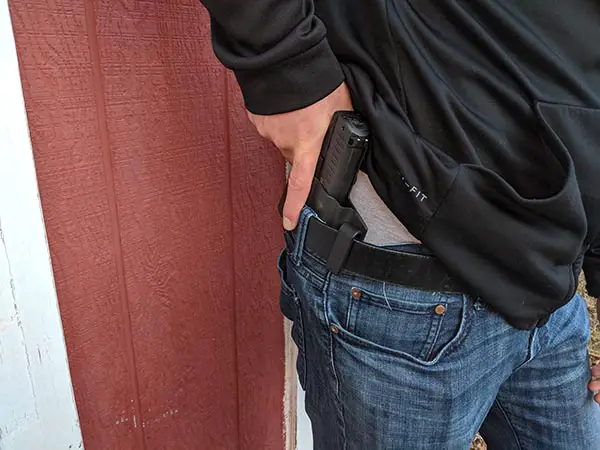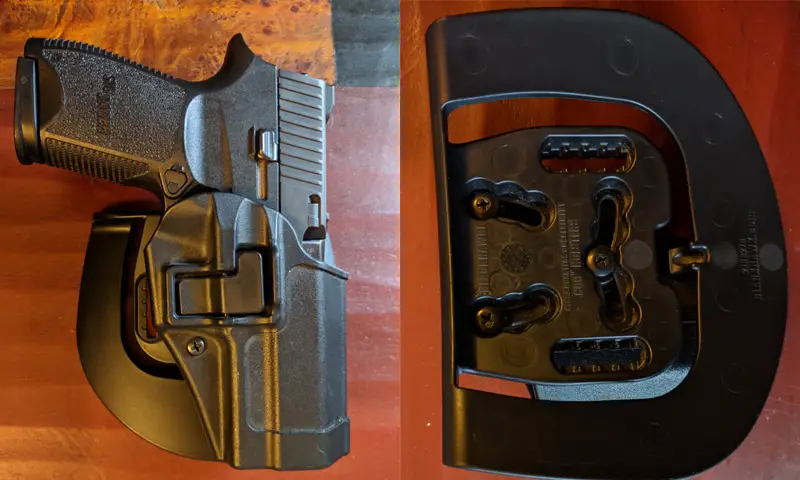Investing in a firearm, along with obtaining your concealed carry permit is no small investment of money or time. Purchasing the necessary accessories, cleaning kits, extra magazines, ammo, holsters, and the like all come at additional expense. Often people will look to circumvent these costs. They will do this by trimming anything they deem unnecessary.
So, Can I conceal carry a gun without a holster? The legality of concealed carrying a gun without a holster varies from state to state. While in some instances it is perfectly legal to carry concealed without a holster, it is never a good idea to do so. There are traditional and non-traditional means of carrying concealed, and I’ll cover why some form of “holster” is your best bet for carrying your weapon responsibly.
Table of Contents
Why You Shouldn’t Conceal Carry A Gun Without A Holster
The primary and most important reason you shouldn’t carry a weapon without a holster is safety. Concealed carrying without a holster is dangerous not only to yourself but in certain scenarios, to those around you.
A holster provides you with a way to secure your firearm, and more importantly acts as a trigger guard. It’s important to remember, that a firearm is a mechanical device, and as such is subject to mechanical failure. Unintentional or accidental discharges, while not commonplace, occur nonetheless. Having this occur while pedestrians are present is a recipe for disaster.
There are a few common methods for carrying concealed without a holster. I’ll explain each scenario and what the dangers are to yourself, and those near you, should you fail to carry responsibly. The methods are:
- belt carry
- pocket carry
- bag carry
Danger Of Carrying A Gun In Belt Without A Holster
The first method of carrying concealed without a holster is the belt carry method. Typically, the person will place the weapon inside the waistband of their pants. The tension of their belt holds the firearm in place. This method is similar to the inside waistband carry (IWB) method, with one potentially fatal difference. Using your belt as the means to secure your firearm, leaves you bereft of any form of trigger guard.
Depending on where in your waistband you carry your weapon, the possibilities for a fatal unintentional discharge increase. If a gentleman carries his weapon in the front of his pants, he’s dangerously close to shooting his own genitals.
However, both men and women are at risk of shooting their own leg by carrying in their waistband and thus puncturing the femoral artery. This is the main pipeline for supplying blood to your leg. Puncturing this without proper and immediate medical treatment is likely to result in death.
Before you dismiss this threat as trivial, think of whether your keys in your front pocket may have ever jabbed you in the leg. Depending on the type of weapon, not a large amount of pressure is required to depress the trigger on your firearm.
Danger Of Carrying A Gun In Your Pocket Without A Holster
Second is the in the pocket method of carrying, which has many of the same potential risks to the holder. However, the difference between this and the first method is that there is direct contact between whatever is in your pocket and your firearm.
If you are carrying anything with a cord, it’s not unreasonable to think that this could become entangled in the trigger. At that point, all it would take is reaching into your pocket and tugging with enough force to cause an unintentional discharge of your weapon.
Furthermore, carrying a weapon in your pocket does not secure your firearm to your person snugly. Items in pockets are prone to falling out, and hitting the ground. This jolt can cause an accidental discharge which endangers those around you.
Depending on the available space in the pocket, and how form fitting your garment is, the firearm may move about in your pocket. This is a quick way to have your safety (assuming your firearm comes with one) disabled.
Danger Of Carrying Off Person Without A Holster
The third, and potentially most dangerous method of carrying without a holster is the off person method. I believe the most commonplace instance of this is when females carry in their purse or another small handbag. However, men can also accomplish this by carrying in a backpack.
I’ll begin by saying I am not a fan of carrying off person in general. I believe it makes quick and easy access to your firearm near impossible. Also, this method increases the likelihood of an assailant gaining possession of your firearm.
When your firearm is un-holstered and free to jostle around your bag, there is an increased chance of something causing an accidental discharge. Either by depressing the trigger, or another means of having the firing pin strike the primer.
Unlike other methods, it is near impossible to predict the angle and direction of the firearm. In the event of an accidental discharge, those in the immediate area surrounding you are at increased risk.
Carrying Your Firearm Holstered Off Person
As previously mentioned, I am not a fan of carrying off person. However, a holstered weapon will at least provide a cover for your trigger. This decreases the likelihood of the weapon becoming entangled in cords or a rogue key from your key chain depressing the trigger.
If you practice this method, I recommend a traditional style holster that secures the firearm with some kind of buckle, strap, or another mechanical lock, which prevents the weapon from becoming displaced.
Ideally, you will use a bag specifically designed for concealed carry. Good versions will contain a compartment dedicated to your weapon, and also offer a trigger guard and way to fasten the weapon in place.
Using A Traditional Holster
There is an abundance of these “traditional” style holsters. Some examples of concealed carry methods include the shoulder holster, in waistband (IWB) holster, and paddle holster. Many of these contain a method to secure the firearm to your person, as well as a means to secure the weapon in place.
Successful models offer a way to keep the firearm attached to your person. Any model you consider should have a trigger guard, and ideally, be form fitted to your selected model of firearm. This creates friction on the firearm to prevent it from falling out of the holster.
Depending on the type of holster, will dictate where it is concealed. I am a proponent of any holster that keeps the muzzle pointed in the safest direction possible in case of a mechanical failure. For this reason, I advocate holsters that keep the muzzle pointed directly at the ground.
Some IWB holsters can be carried in the small of your back, which can put those nearest you (to your left or right depending on your draw hand) at risk. Other IWB holsters require you carry it near your appendix, and we cover the dangers of this method in an earlier section.
Furthermore, shoulder rigs keep the muzzle pointed directly behind you. Pity the poor soul who catches a bullet in the chest because of your choice in a holster and the fact he or she just happened to be standing behind you.
Using Traditional Holster Alternatives
Beyond the traditional holster methods, there are a plethora of options. Some of these include belly belts, fanny packs, and concealed carry apparel. This grouping is by far my preferred method of concealed carry.
Belly belts typically are kept close to the body, offer a trigger guard, and keep the pistol pointed in the downward position. Fanny packs are similar, but are worn outside of your attire, rather than underneath, and appear innocuous.
However, you may have noticed that fanny packs are out of fashion at the time of writing. I have seen someone use it wisely while partaking in physical activities because of the redundant level of security it offers.
Successful models of both fanny packs and belly belts should allow for quick access to your firearm. The muzzle should be kept pointed downward rather than laterally. Ensure that you get a durable model. Many of these are universal fit, but finding one tailored to your specific model, is all the better.
Concealed carry apparel, designed specifically for carrying your firearm is optimal for every day carry. You should ensure the fit is correct, and that the firearm is secured tightly. Many of these options offer either ambidextrous carry methods and/or a method to carry extra magazines.
I prefer under layer rather than over wear for concealed carry in the spring and summer seasons. I personally have multiple versions of this concealed carry compression shirt on Amazon.
The Practicality of Concealed Carry With A Holster
Excluding concealed carry off person, which I’ve noted I am against, carrying with a holster offers real benefits. When you carry using clothing designed specifically for concealed carry, or with a holster, the weapon is secured in the same position and location every time.
Unless you are wearing skin-tight clothing and the contents of your pockets do not shift, your weapon could end up resting in any number of positions when you carry without a holster. Because of this, it is near impossible to consistently replicate these scenarios on the range.
Drawing and aiming your firearm effectively are perfected through repetition. Gaining familiarity with your weapon is best practiced with a minimal number of divergent variables.
Parting Shots
While certain locales may allow you to carry a firearm without a holster, it is certainly not the norm, and never a good idea. Being a responsible gun owner begins with knowing what you can and can’t lawfully do. The next step is knowing what you should do.
Remember that you have the responsibility to yourself and those around you to do everything you can to keep them safe from outside dangers as well as yourself.
If you’re looking for other helpful articles on concealed carry, check out our dedicated section for all things concealed carry.










